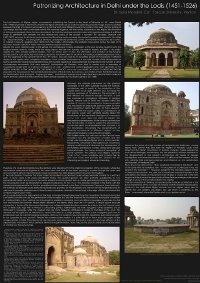| Author | Sara Mondini |
| Title | Patronizing Architecture in Delhi under the Lodis and Babur |
Abstract
The strong impulse that the Lodi dynasty, since its accession to the power, was able to impress to the funerary architecture is still far to be completely explained. In fact, despite the fewer examples of mausoleums dated to the previous Delhi dynasties, with the opening of the second half of the XV century, we assist to an incredible spread of tombs in different districts of the capital, often collected in complexes. If we consider their presence in the context of a wider development of architecture, their number appears as disproportionate if compared to the number of other relevant monuments.
The last phase of the Delhi Sultanate, before the arrival of Babur and the foundation of the new Empire, could had been characterized by a peculiar role of Sufism, as happened in other Indian sultanates, where the relations between the spiritual power of Sufis and the power of the court seem to have determined the fortune of sovereigns and even conditioned the patronized architecture, its typology and location. We could gather, from Babur’s memories, his respect for his predecessors as for Islam and Sufism, despite we don’t have a comparative number of architectural remains attributable to his patronage.
The purpose of the article is to trace out and analyze the growing diffusion of mausoleums in Delhi during the Lodi reign. Mapping the original dislocation of Delhi’s necropolis during the XV and XVI centuries, considering some of the most representative examples and through the comparison with other coeval regional productions, the aim is to analyse architecturally the passage to the first phase of the Mughal Empire. Moreover, it is important to define how the role elected for mausoleums was probably strictly connected with the political and social structure of the Lodi’s court and in which way it could have been conserved and inherited later under the Mughal Empire.
